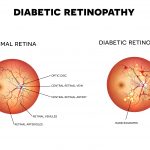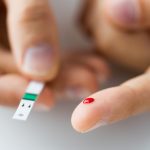Diabetes and LASIK – Is the Condition Disqualifying?
Written by Dr. David Evans Last modified on April 22, 2019
Diabetes is a common group of metabolic diseases marked by abnormally high blood sugar levels. Elevated blood sugar levels can cause all sorts of health-related problems, including doubling the risk of heart disease and stroke. Diabetes can also wreak havoc on vision health in the form of diabetic retinopathy, the leading cause of blindness among people with diabetes.
Although it’s true that the typical intersection between diabetic patient and eye surgeon relates to the diagnosis and treatment of diabetic retinopathy, it’s not the only one. Some diabetic patients want to see better without their glasses or contact lenses and are therefore interested in refractive surgery like LASIK. The question is, are diabetics candidates for LASIK or is the condition disqualifying?
Yes, with a But

If you have Type 1 or Type 2 diabetes and have experienced an unrelated change in vision that you’re seeking to treat with LASIK, you’ll be glad to hear that it is possible to undergo refractive surgery. But… there are a number of considerations that must be carefully evaluated by your eye surgeon before it’s possible to determine your candidacy.
What are the Considerations?
The longer that you’ve had diabetes, the greater your risk for developing diabetic retinopathy. If changes in your vision are caused by diabetes, refractive surgery will offer limited benefit. (LASIK corrects refractive errors like myopia, hyperopia and astigmatism.)
Diabetes is considered a “relative contraindication” for refractive surgery (which is an elective treatment) by the FDA and the American Academy of Ophthalmology. This means that under certain conditions, people with diabetes are restricted from getting surgery like LASIK. Uncontrolled diabetes — which occurs when diabetics do not (or cannot) properly manage their blood sugar levels — is an “absolute” contraindication.
For diabetic patients interested in correcting a refractive error with LASIK, this means that candidacy essentially boils down to status, management and monitoring of the condition.
Candidacy
The first step in determining whether a diabetic patient is fit for LASIK is evaluating blood sugar levels and diabetes history. Eye doctors will want to know how long the patient has had diabetes and assess the stability of the patient’s prescription. Abnormalities in blood sugar levels can cause fluctuations in prescriptions, so it’s essential that vision is stable and blood sugar controlled before correction can be considered.
In addition to speaking with the patient, the eye surgeon may also wish to speak with the primary care physician to obtain additional information about the patient’s hemoglobin A1c level (average blood sugar over the past two-to-three months) and blood pressure history. Assuming that the patient’s vision is stable and blood sugar levels well managed and controlled, the eye surgeon can then assess ocular health. This will include evaluation of corneal health and of course a screening for diabetic retinopathy.
LASIK is preferred over PRK for diabetic patients out of concerns related to the longer healing time. Due to impaired wound healing, diabetic patients can end up with permanent corneal haze after PRK, making LASIK a safer option. LASIK candidacy is more stringent than PRK (check out our article on LASIK vs. PRK for more information), meaning that even if a diabetic patient’s prescription and blood sugar levels are stable and well-managed, he/she may still not be a good candidate for refractive surgery if they do not meet the criteria for LASIK.
The Recovery
Diabetic LASIK patients will experience a longer healing period than non-diabetic patients because of the associated impaired wound healing. The risk of infection is greater, meaning that it’s important that the patient is monitored closely after treatment during the recovery period. Steroid eye drops are frequently used during the recovery process, but this can be problematic for diabetics. Absorption of steroids into the bloodstream can spike blood glucose, so doctors advise blocking the tear ducts during application.
Dry eye after LASIK is another concern for diabetics. Although this is a potential side effect for any LASIK patient, it can be more severe for diabetic patients, requiring increased application of eye drops. Preservative-free drops are recommended every 15 to 30 minutes in the days after LASIK.
The Bottom Line
If you have diabetes and have a refractive error, LASIK refractive surgery may be an option. But it’s important that you are fully aware of the additional hurdles that must be cleared in order to qualify for treatment.
If you are interested in LASIK, but not sure whether your diabetes may be disqualifying, setup a consultation with a qualified eye surgeon to get additional information and begin the evaluation process. We feature a number of top LASIK surgeons on Better Vision Guide who can meet with prospective patients to determine candidacy and discuss alternative options, if need be.




